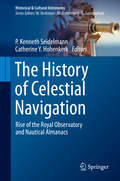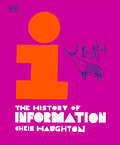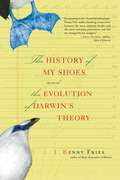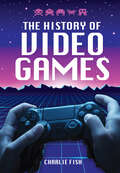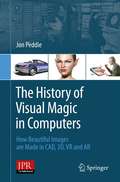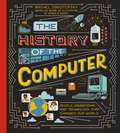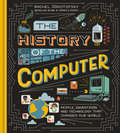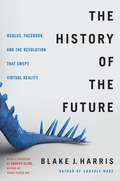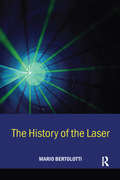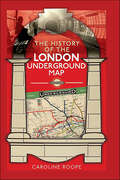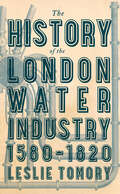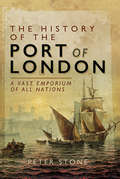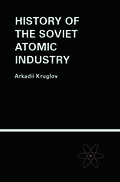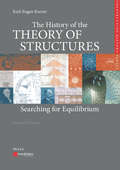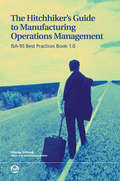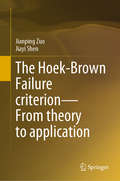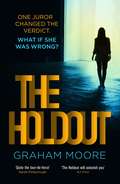- Table View
- List View
The History of Celestial Navigation: Rise of the Royal Observatory and Nautical Almanacs (Historical & Cultural Astronomy)
by P. Kenneth Seidelmann Catherine Y. HohenkerkThis edited volume charts the history of celestial navigation over the course of five centuries. Written by a group of historians and scientists, it analyzes how competing navigation systems, technologies, and institutions emerged and developed, with a focus on the major players in the US and the UK.The history covers the founding of the Royal Observatory; the first printing of a Nautical Almanac; the founding of the US and UK Nautical Almanac Offices; the creation of international standards for reference systems and astronomical constants; and the impact of 20th century technology on the field, among other topics. Additionally, the volume analyzes the present role and status of celestial navigation, particularly with respect to modern radio and satellite navigation systems.With its diverse authorship and nontechnical language, this book will appeal to any reader interested in the history of science, technology, astronomy, and navigation over the ages.
The History of Cyclodextrins (Environmental Chemistry for a Sustainable World #52)
by Eric Lichtfouse Sophie Fourmentin Grégorio CriniThis book presents the historical development of Cyclodextrins by scientists who have made outstanding contribution to the field. Cyclodextrins are safe, cage-like molecules that have found major applications in many industrial sectors such as medicine, food, agriculture, environment and chemistry.
The History of Human Factors and Ergonomics
by David MeisterHuman factors/ergonomics (HFE) as a discipline has grown by accretions rather than having been developed systematically and deliberately. Therefore, this book's goal creates a formal conceptual structure for HFE. It is intended as a contribution to cultural history because (a) ours is a technological civilization, and (b) one cannot understand technology outside of the various disciplines that make up that technology. A disciplinary history is highly specialized, but the author maintains that HFE is distinctive in being the only discipline that relates humans to technology. Other behavioral disciplines like anthropology have little connection with technology, and this is what makes HFE important in the present historical era.
The History of Human Space Flight
by Ted SpitzmillerMilitary Writers Society of America Awards, Gold Medal for History Highlighting men and women across the globe who have dedicated themselves to pushing the limits of space exploration, this book surveys the programs, technological advancements, medical equipment, and automated systems that have made space travel possible. Beginning with the invention of balloons that lifted early explorers into the stratosphere, Ted Spitzmiller describes how humans first came to employ lifting gasses such as hydrogen and helium. He traces the influence of science fiction writers on the development of rocket science, looks at the role of rocket societies in the early twentieth century, and discusses the use of rockets in World War II warfare. Spitzmiller considers the engineering and space medicine advances that finally enabled humans to fly beyond the earth's atmosphere during the space race between the United States and the Soviet Union. He recreates the excitement felt around the world as Yuri Gagarin and John Glenn completed their first orbital flights. He recounts triumphs and tragedies, such as Neil Armstrong's "one small step" and the Challenger and Columbia disasters. The story continues with the development of the International Space Station, NASA's interest in asteroids and Mars, and the emergence of China as a major player in the space arena. Spitzmiller shows the impact of space flight on human history and speculates on the future of exploration beyond our current understandings of physics and the known boundaries of time and space.
The History of Information
by Chris HaughtonThe debut nonfiction book from bestselling author and illustrator Chris Haughton that explores the story of information throughout human history.We are used to technology improving all the time. Next year we will have better phones, cars, and technology. What is it that makes technology improve rather than stay static or even fall into decline? The answer is information. If we can record knowledge we can collect and share it. We can continue adding to it and it grows and grows.It hasn't always been like this. For a long time, human progress was very slow or static. At some points it felt like our progress even ran backward! But the ability to record information in the form of writing and collecting data has caused an explosion of technological progress. This book tells the story of how we came to collect information, and what it means for us.
The History of My Shoes and the Evolution of Darwin's Theory
by Kenny Fries<p>In The History of My Shoes, Kenny Fries narrates two stories: the development of the theory of "survival of the fittest," as articulated by Charles Darwin and Alfred Russel Wallace; and the history of his ever-changing, made-to-order, orthopedic shoes. <p>The famously important first story, as told by Kenny Fries, is a condensed and colorful account of the race between Darwin and Wallace to formulate their groundbreaking theories. <p>At the same time, Fries, a gay and disabled man, tells a deeply personal story of the evolving consciousness of his own "adaptations," represented by his shoes. As a child, Fries was abused by both his father and brother, and emerged into adulthood swaddled in ambiguities of self and memory. <p>These he has explored in his brutally frank memoir, Body, Remember. In this poetic, introspective book, Kenny Fries imaginatively illustrates how his identities intersect. He writes, "Much of my own work the past fifteen years has been concerned with the body, as both subject and metaphor; as the place where the personal becomes the universal; as the site of memory, language, and desire." <P>Although only the "fittest" may survive, Fries learns that adaptation and variation are critical to survival. What is deemed normal, or even perfect, are passing phases of the ever-changing embodiment of nature in our world. In the end, Darwin and Wallace's discoveries resonate with Fries's own story in The History of My Shoes.
The History of Video Games
by Charlie FishThis book is a potted history of video games, telling all the rollercoaster stories of this fascinating young industry that’s now twice as big globally than the film and music industries combined. Each chapter explores the history of video games through a different lens, giving a uniquely well-rounded overview. Packed with pictures and stats, this book is for video gamers nostalgic for the good old days of gaming, and young gamers curious about how it all began. If you’ve ever enjoyed a video game, or you just want to see what all the fuss is about, this book is for you. There are stories about the experimental games of the 1950s and 1960s; the advent of home gaming in the 1970s; the explosion – and implosion – of arcade gaming in the 1980s; the console wars of the 1990s; the growth of online and mobile games in the 2000s; and we get right up to date with the 2010s, including such cultural phenomena as twitch.tv, the Gamergate scandal, and Fortnite. But rather than telling the whole story from beginning to end, each chapter covers the history of video games from a different angle: platforms and technology, people and personalities, companies and capitalism, gender and representation, culture, community, and finally the games themselves.
The History of Visual Magic in Computers
by Jon PeddieIf you have ever looked at a fantastic adventure or science fiction movie, or an amazingly complex and rich computer game, or a TV commercial where cars or gas pumps or biscuits behaved liked people and wondered, "How do they do that?", then you've experienced the magic of 3D worlds generated by a computer. 3D in computers began as a way to represent automotive designs and illustrate the construction of molecules. 3D graphics use evolved to visualizations of simulated data and artistic representations of imaginary worlds. In order to overcome the processing limitations of the computer, graphics had to exploit the characteristics of the eye and brain, and develop visual tricks to simulate realism. The goal is to create graphics images that will overcome the visual cues that cause disbelief and tell the viewer this is not real. Thousands of people over thousands of years have developed the building blocks and made the discoveries in mathematics and science to make such 3D magic possible, and The History of Visual Magic in Computers is dedicated to all of them and tells a little of their story. It traces the earliest understanding of 3D and then foundational mathematics to explain and construct 3D; from mechanical computers up to today's tablets. Several of the amazing computer graphics algorithms and tricks came of periods where eruptions of new ideas and techniques seem to occur all at once. Applications emerged as the fundamentals of how to draw lines and create realistic images were better understood, leading to hardware 3D controllers that drive the display all the way to stereovision and virtual reality.
The History of Water Management in the Iberian Peninsula: Between the 16th and 19th Centuries (Trends in the History of Science)
by Ana Duarte Rodrigues Carmen Toribio MarínThis volume approaches the history of water in the Iberian Peninsula in a novel way, by linking it to the ongoing international debate on water crisis and solutions to overcome the lack of water in the Mediterranean.What water devices were found? What were the models for these devices? How were they distributed in the villas and monastic enclosures? What impact did hydraulic theoretical knowledge have on these water systems, and how could these systems impact on hydraulic technology? Guided by these questions, this book covers the history of water in the most significant cities, the role of water in landscape transformation, the irrigation systems and water devices in gardens and villas, and, lastly, the theoretical and educational background on water management and hydraulics in the Iberian Peninsula between the sixteenth and the nineteenth centuries.Historiography on water management in the territory that is today Spain has highlighted the region’s role as a mediator between the Islamic masters of water and the Christian world. The history of water in Portugal is less known, and it has been taken for granted that is similar to its neighbour. This book compares two countries that have the same historical roots and, therefore, many similar stories, but at the same time, offers insights into particular aspects of each country. It is recommended for scholars and researchers interested in any field of history of the early modern period and of the nineteenth century, as well as general readers interested in studies on the Iberian Peninsula, since it was the role model for many settlements in South America, Asia and Africa.
The History of the Computer: People, Inventions, And Technology That Changed Our World
by Rachel IgnotofskyExplore the fascinating history of the computer, and the people who made them, in this beautifully illustrated guide for children by bestselling author and illustrator Rachel Ignotofsky.Computers make our lives easier in so many ways - they help us do our work, get directions, check the weather, exercise, shop and understand what's happening around the world. But who created them, and why? How have they transformed the way we interact with our surroundings and each other?Packed with accessible information, fun facts and discussion starters, this charmingly illustrated book takes you from the ancient world to the modern day, focusing on important inventions from the earliest known counting systems (such as the Incan quipu) to the sophisticated algorithms behind AI, space travel and wearable tech. The History of the Computer also profiles a global and diverse range of key players and creators - from An Wang and Margaret Hamilton to Steve Jobs and Tim Berners-Lee - and illuminates their goals, their intentions and the impact of their inventions on our everyday lives.This entertaining and educational journey from the bestselling author of Women in Science will help you understand our most important machines and how we can use them to enhance the way we live. You'll never look at your phone the same way again!
The History of the Computer: People, Inventions, and Technology that Changed Our World
by Rachel IgnotofskyA strikingly illustrated overview of the computing machines that have changed our world—from the abacus to the smartphone—and the people who made them, by the New York Times bestselling author and illustrator of Women in Science.Computers are everywhere and have impacted our lives in so many ways. But who created them, and why? How have they transformed the way that we interact with our surroundings and each other?Packed with accessible information, fun facts, and discussion starters, this charming and art-filled book takes you from the ancient world to the modern day, focusing on important inventions, from the earliest known counting systems to the sophisticated algorithms behind AI. The History of the Computer also profiles a diverse range of key players and creators—from An Wang and Margaret Hamilton to Steve Jobs and Sir Tim Berners-Lee—and illuminates their goals, their intentions, and the impact of their inventions on our everyday lives. This entertaining and educational journey will help you understand our most important machines and how we can use them to enhance the way we live. You&’ll never look at your phone the same way again!
The History of the Future: Oculus, Facebook, and the Revolution That Swept Virtual Reality
by Blake J. HarrisThe author of Console Wars reveals the story behind Oculus and its quest for virtual reality: “Masterful . . . filled with unforgettable characters” (Forbes).From iconic books like Neuromancer to blockbuster films like The Matrix, virtual reality has offered a tantalizing vision of the future. But outside of a few research labs and military training facilities, this technology was mere science fiction. Until 2012, when Oculus founder Palmer Luckey—then just a teenage dreamer living alone in a camper trailer—invents a device that has the potential to change the world.With the help of a videogame legend, a serial entrepreneur, and many other colorful characters, Luckey’s scrappy startup kickstarts a revolution and sets out to bring VR to the masses. What follows is the ultimate entrepreneurial journey, a tale of battles won and lost, lessons learned and shocking turns—including an unlikely multi-billion-dollar acquisition by Facebook’s Mark Zuckerberg.Drawing on over a hundred interviews with the key players driving this revolution, The History of the Future weaves together a rich, cinematic narrative that captures the breakthroughs, breakdowns, and human drama of trying to change the world. The result is a supremely entertaining look at the birth of a game-changing new industry.
The History of the Laser
by Mario BertolottiSince the invention of the first working laser in 1960, development of these devices has progressed at an unprecedented rate, to the extent that the laser is now a common part of everyday life, from the semiconductor laser used in CD players and telecommunication systems to the high power eximer lasers used in manufacturing processes. This book tra
The History of the London Underground Map
by Caroline RoopeFew transportation maps can boast the pedigree that London’s iconic ‘Tube’ map can. Sported on t-shirts, keyrings, duvet covers, and most recently, downloaded an astonishing twenty million times in app form, the map remains a long-standing icon of British design and ingenuity. Hailed by the art and design community as a cultural artifact, it has also inspired other culturally important pieces of artwork, and in 2006 was voted second in BBC 2’s Great British Design Test. But it almost didn’t make it out of the notepad it was designed in. The story of how the Underground map evolved is almost as troubled and fraught with complexities as the transport network it represents. Mapping the Underground was not for the faint-hearted – it rapidly became a source of frustration, and in some cases obsession – often driving its custodians to the point of distraction. The solution, when eventually found, would not only revolutionise the movement of people around the city but change the way we visualise London forever. Caroline Roope’s wonderfully researched book casts the Underground in a new light, placing the world’s most famous transit network and its even more famous map in its wider historical and cultural context, revealing the people not just behind the iconic map, but behind the Underground’s artistic and architectural heritage. From pioneers to visionaries, disruptors to dissenters – the Underground has had them all – as well as a constant stream of (often disgruntled) passengers. It is thanks to the legacy of a host of reformers that the Tube and the diagram that finally provided the key to understanding it, have endured as masterpieces of both engineering and design.
The History of the London Water Industry, 1580–1820
by Leslie TomoryHow did pre-industrial London build the biggest water supply industry on earth?Beginning in 1580, a number of competing London companies sold water directly to consumers through a large network of wooden mains in the expanding metropolis. This new water industry flourished throughout the 1600s, eventually expanding to serve tens of thousands of homes. By the late eighteenth century, more than 80 percent of the city’s houses had water connections—making London the best-served metropolis in the world while demonstrating that it was legally, commercially, and technologically possible to run an infrastructure network within the largest city on earth.In this richly detailed book, historian Leslie Tomory shows how new technologies imported from the Continent, including waterwheel-driven piston pumps, spurred the rapid growth of London’s water industry. The business was further sustained by an explosion in consumer demand, particularly in the city’s wealthy West End. Meanwhile, several key local innovations reshaped the industry by enlarging the size of the supply network. By 1800, the success of London’s water industry made it a model for other cities in Europe and beyond as they began to build their own water networks. The city’s water infrastructure even inspired builders of other large-scale urban projects, including gas and sewage supply networks.The History of the London Water Industry, 1580–1820 explores the technological, cultural, and mercantile factors that created and sustained this remarkable industry. Tomory examines how the joint-stock form became popular with water companies, providing a stable legal structure that allowed for expansion. He also explains how the roots of the London water industry’s divergence from the Continent and even from other British cities was rooted both in the size of London as a market and in the late seventeenth-century consumer revolution. This fascinating and unique study of essential utilities in the early modern period will interest business historians and historians of science and technology alike.
The History of the London Water Industry, 1580–1820
by Leslie TomoryThis in-depth study explores the technological, cultural, and mercantile factors behind the infrastructure that transformed early modern London.Beginning in 1580, a number of competing London companies sold water directly to consumers through a large network of wooden mains in the expanding metropolis. This new water industry flourished throughout the 1600s, eventually expanding to serve tens of thousands of homes. By the late eighteenth century, more than 80 percent of the city’s houses had water connections—making London the best-served metropolis in the world while demonstrating that it was legally, commercially, and technologically possible to run an infrastructure network within the largest city on earth.Historian Leslie Tomory shows how an explosion of consumer demand and new technologies imported from the Continent spurred the rapid growth of London’s water industry. Meanwhile, several key local innovations reshaped the industry by enlarging the size of the supply network. By 1800, the success of London’s water industry made it a model for cities across Europe and beyond. It even inspired builders of other large-scale urban projects, including gas and sewage supply networks.
The History of the Port of London: A Vast Emporium of All Nations
by Peter Stone&“This meticulously researched account underlines the importance of the capital&’s docklands . . . from Roman landing to modern financial centre.&” —Discover Britain The River Thames has been integral to the prosperity of London since Roman times. Explorers sailed away on voyages of discovery to distant lands. Colonies were established and a great empire grew. Funding their ships and cargoes helped make the City of London into the world&’s leading financial center. In the nineteenth century a vast network of docks was created for ever-larger ships, behind high, prison-like walls that kept them secret from all those who did not toil within. Sail made way for steam as goods were dispatched to every corner of the world. In the nineteenth century London was the world&’s greatest port city. In the Second World War the Port of London became Hitler&’s prime target. It paid a heavy price but soon recovered. Yet by the end of the 20th century the docks had been transformed into Docklands, a new financial center. The History of the Port of London: A Vast Emporium of Nations is the fascinating story of the rise and fall and revival of the commercial river. The only book to tell the whole story and bring it right up to date, it charts the foundation, growth and evolution of the port and explains why for centuries it has been so important to Britain&’s prosperity. This book will appeal to those interested in London&’s history, maritime and industrial heritage, the Docklands and East End of London, and the River Thames.
The History of the Soviet Atomic Industry
by Arkadii KruglovFor the first time, readers can discover the numerous pioneers of the Soviet nuclear industry, including the role of scientific supervisors of Russia's nuclear project and the statesmen who coordinated the function of the atomic industry in the former USSR. This is a detailed account, translated to English for the first time, of the development of
The History of the Theory of Structures: Searching for Equilibrium (Edition Bautechnikgeschichte / Construction History)
by Karl-Eugen KurrerTen years after the publication of the first English edition of The History of the Theory of Structures, Dr. Kurrer now gives us a much enlarged second edition with a new subtitle: Searching for Equilibrium. The author invites the reader to take part in a journey through time to explore the equilibrium of structures. That journey starts with the emergence of the statics and strength of materials of Leonardo da Vinci and Galileo, and reaches its first climax with Coulomb's structural theories for beams, earth pressure and arches in the late 18th century. Over the next 100 years, Navier, Culmann, Maxwell, Rankine, Mohr, Castigliano and Müller-Breslau moulded theory of structures into a fundamental engineering science discipline that - in the form of modern structural mechanics - played a key role in creating the design languages of the steel, reinforced concrete, aircraft, automotive and shipbuilding industries in the 20th century. In his portrayal, the author places the emphasis on the formation and development of modern numerical engineering methods such as FEM and describes their integration into the discipline of computational mechanics. Brief insights into customary methods of calculation backed up by historical facts help the reader to understand the history of structural mechanics and earth pressure theory from the point of view of modern engineering practice. This approach also makes a vital contribution to the teaching of engineers. Dr. Kurrer manages to give us a real feel for the different approaches of the players involved through their engineering science profiles and personalities, thus creating awareness for the social context. The 260 brief biographies convey the subjective aspect of theory of structures and structural mechanics from the early years of the modern era to the present day. Civil and structural engineers and architects are well represented, but there are also biographies of mathematicians, physicists, mechanical engineers and aircraft and ship designers. The main works of these protagonists of theory of structures are reviewed and listed at the end of each biography. Besides the acknowledged figures in theory of structures such as Coulomb, Culmann, Maxwell, Mohr, Müller-Breslau, Navier, Rankine, Saint-Venant, Timoshenko and Westergaard, the reader is also introduced to G. Green, A. N. Krylov, G. Li, A. J. S. Pippard, W. Prager, H. A. Schade, A. W. Skempton, C. A. Truesdell, J. A. L. Waddell and H. Wagner. The pioneers of the modern movement in theory of structures, J. H. Argyris, R. W. Clough, T. v. Kármán, M. J. Turner and O. C. Zienkiewicz, are also given extensive biographical treatment. A huge bibliography of about 4,500 works rounds off the book. New content in the second edition deals with earth pressure theory, ultimate load method, an analysis of historical textbooks, steel bridges, lightweight construction, theory of plates and shells, Green's function, computational statics, FEM, computer-assisted graphical analysis and historical engineering science. The number of pages now exceeds 1,200 - an increase of 50% over the first English edition. This book is the first all-embracing historical account of theory of structures from the 16th century to the present day.
The History, Use, Disposition and Environmental Fate of Agent Orange
by Alvin Lee YoungFor almost four decades, controversy has surrounded the tactical use of herbicides in Southeast Asia by the United States military. Few environmental or occupational health issues have received the sustained international attention that has been focused on Agent Orange, the major tactical herbicide deployed in Southern Vietnam. With the opening and establishment of normal relations between the United States and the Socialist Republic of Vietnam in 1995, the time has come for a thorough re-examination of the military use of Agent Orange and other "tactical herbicides" in Southern Vietnam, and the subsequent actions that have been taking place since their use in Vietnam. The United States Department of Defense has had the major role in all military operations involving the use of tactical herbicides, including that of Agent Orange. This included the Department's purchase, shipment and tactical use of herbicides in Vietnam, its role in the disposition of Agent Orange after Vietnam, its role in conducting long-term epidemiological investigations of the men of Operation RANCH HAND, and its sponsorship of ecological and environmental fate studies. This book was commissioned by The Office of the Deputy Under Secretary of Defense (Installations and Environment) with the intent of providing documentation of the knowledge on the history, use, disposition and environmental fate of Agent Orange and its associated dioxin.
The Hitchhiker’s Guide to Manufacturing Operations Management: ISA-95 Best Practices Book 1.0
by Charlie GiffordDo you want to dramatically lower total cost of ownership (TCO) for manufacturing IT architectures and manufacturing, as well as reduce supply chain operational costs? The methodologies and technical applications presented in this first annual ISA-95/MESA Best Practices book will help get you started on the right track. This book provides in-depth coverage on how you can apply ISA-95, Enterprise-Control Integration Standard, to help lower TCO of manufacturing operations management (MOM) systems and their enterprise and plant interfaces. It consists of a series of related "how-to" white papers described in the context of ISA-95 models, definitions, and data exchanges. To be competitive, actual manufacturing operations activities must be highly interactive in supply chain and enterprise processes for effective collaboration and competition. This is the domain of collaborative and flexible MOM system architectures. This book explains the business cases for using evolving ISA-95 methods to effectively design, implement, change and optimize the MOM business processes and supporting MOM system architectures within the distributed pull supply chains.
The Hive Detectives: Chronicle of a Honey Bee Catastrophe (Scientists in the Field)
by Loree Griffin Burns Ellen HarasimowiczWithout honey bees the world would be a different place. There would be no honey, no beeswax for candles, and, worst of all, barely a fruit, nut, or vegetable to eat. So imagine beekeeper Dave Hackenburg's horror when he discovered twenty million of his charges had vanished. Those missing bees became the first casualties of a mysterious scourge that continues to plague honey bee populations today. In The Hive Detectives, Loree Griffin Burns profiles bee wranglers and bee scientists who have been working to understand colony collapse disorder, or CCD. In this dramatic and enlightening story, readers explore the lives of the fuzzy, buzzy insects and learn what might happen to us if they were gone.
The Hoek-Brown Failure criterion—From theory to application
by Jianping Zuo Jiayi ShenThis book provides a comprehensive coverage of the theory and principle of the Hoek-Brown (HB) failure criterion, methods or guidelines for estimating the HB input parameters, and the methodology of application of the HB criterion in rock engineering projects. It aims to help researchers, engineers and research students who work in the area of rock mechanics and mining engineering. Academics can quickly obtain an overview of the state of the art of the theory and principle of the Hoek-Brown criterion by reading the book before they advance their researches on the topics related to rock failure criteria. Geotechnical engineers can select appropriate Hoek-Brown input parameters for the design and analysis of rock engineering projects with the help of the principles introduced in this book. Research students may use the book as a textbook to learn the principle of rock mechanics related to rock mass properties.
The Holdout: The tense, gripping Richard and Judy Book Club pick for 2021
by Graham Moore'The most gripping and satisfying thriller I've read in more than a decade' Sophie Hannah'One of the best legal thrillers ... as elegant and gripping as Scott Turow's Presumed Innocent' Daily Mail'Quite the tour de force! Twelve Angry Men meets Chinatown and creates something of its own' Sarah Pinborough'This is a tense, emotionally charged, scary-good, stand-out read' Caroline Kepnes**********MAJOR TV SERIES COMING SOON - FROM THE PEOPLE WHO BROUGHT YOU NETFLIX'S UNBELIEVABLE... One juror changed the verdict. What if she was wrong?'Ten years ago we made a decision together...'Fifteen-year-old Jessica Silver, heiress to a billion-dollar fortune, vanishes on her way home from school. Her teacher, Bobby Nock, is the prime suspect. It's an open and shut case for the prosecution, and a quick conviction seems all but guaranteed. Until Maya Seale, a young woman on the jury, persuades the rest of the jurors to vote not guilty: a controversial decision that will change all of their lives forever.Ten years later, one of the jurors is found dead, and Maya is the prime suspect.The real killer could be any of the other ten jurors. Is Maya being forced to pay the price for her decision all those years ago?**********'Plunge a syringe filled with adrenaline into the heart of Twelve Angry Men and you've got The Holdout: the first legal thriller in thirty years - ever since Presumed Innocent and A Time to Kill electrified readers the world over - to rank alongside those two modern classics.' AJ Finn'A page-turning legal thriller with a twisty and absolutely riveting plot ... plus a strong and compelling female heroine. You won't be able to put this one down!' Lisa Scottoline'Clever, well-written and twistier than a can of silly-string. You absolutely need to read The Holdout!' Emma Kavanagh'Amazing thriller, deserves to be one of the biggest books of 2020' Michelle Davies'Terrific, twisty and well-structured thriller' Adele Geras
